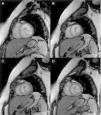A 36-year-old woman was referred for medical evaluation prior to non-cardiac surgery. She was healthy and only complained of sporadic palpitations. The 12-lead electrocardiogram showed sinus rhythm and left bundle branch block. Transthoracic echocardiography revealed a normally functioning, slightly dilated left ventricle (LV), with the interventricular septum bulging toward the right ventricle (RV), which was elongated and wrapped around the LV (Figure 1; Supplementary material Videos S1 and S2). The papillary muscles were structurally abnormal and presented an apical origin, findings better visualized in contrast images (Figure 2; Videos S3–S5). Cardiac magnetic resonance confirmed the presence of a truncated LV, a complex network of papillary muscles of apical origin, and a banana-shaped, normally functioning RV (Figures 3 and 4; Videos S6–S8). There was no evidence of fatty infiltration or late enhancement with gadolinium.
During a three-year follow-up, the patient remained asymptomatic with no evidence of arrhythmias in serial Holter monitoring and with no signs of heart failure.
These findings are consistent with LV apical hypoplasia, a recently recognized cardiomyopathy, with only 15 cases reported since its first description in 2004. The age of diagnosis (3 months to 63 years) and clinical presentation vary widely, with most individuals remaining asymptomatic or mildly symptomatic for variable periods of time. However, a case of a 19-year-old male with a rapidly fatal presentation has been described. The precise pathophysiological basis and natural history of this entity remain unknown.
To our knowledge, this is the first case described in the Portuguese population.
Ethical disclosuresProtection of human and animal subjectsThe authors declare that no experiments were performed on humans or animals for this study.
Confidentiality of dataThe authors declare that they have followed the protocols of their work center on the publication of patient data and that all the patients included in the study received sufficient information and gave their written informed consent to participate in the study.
Right to privacy and informed consentThe authors declare that no patient data appear in this article.
Conflicts of interestThe authors have no conflicts of interest to declare.












